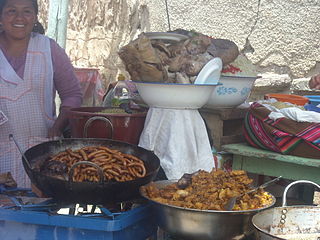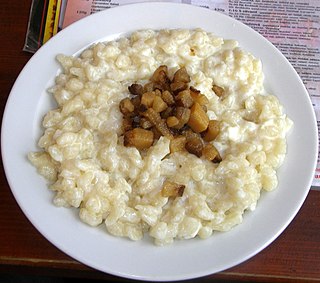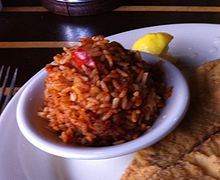
Soul food is an ethnic cuisine traditionally prepared and eaten by African Americans, originating in the Southern United States. There is no agreed upon definition of Soul Food that differentiates it from Southern food, but some people will consider Southern Food Soul food when it is prepared by Black Americans. Soul food originated with the foods that were made by enslaved black people on Southern plantations during the Antebellum period; however, some assert it is strongly influenced by the traditional practices of West Africans and Southeastern Native Americans from its inception. Due to the historical presence of African Americans in the region, soul food is closely associated with the cuisine of the American South. The expression "soul food" originated in the mid-1960s, when "soul" was a common word used to describe African-American culture.

The cuisine of the Southern United States encompasses diverse food traditions of several subregions, including Tidewater, Appalachian, Lowcountry, Cajun, Creole, and Floribbean cuisine. In recent history, elements of Southern cuisine have spread to other parts the United States, influencing other types of American cuisine.

Gumbo is a hearty stew popular in the U.S. state of Louisiana, and is the official state cuisine. Gumbo consists primarily of a strongly flavored stock, meat or shellfish, a thickener, and the Creole "holy trinity" ― celery, bell peppers, and onions. Gumbo is often categorized by the type of thickener used, whether okra or filé powder.

South American cuisine has many influences, due to the ethnic fusion of South America. The most characteristic are Native American, African, Spanish, Italian, Portuguese, and Indian-South Asian. However, there is a mix of European, North American, and indigenous cuisines. The customs and food products greatly vary according to the physically distinct regions.

Latin American cuisine is the typical foods, beverages, and cooking styles common to many of the countries and cultures in Latin America. Latin America is a highly racially, ethnically, and geographically diverse with varying cuisines. Some items typical of Latin American cuisine include maize-based dishes arepas, empanadas, pupusas, tacos, tamales, tortillas and various salsas and other condiments. Sofrito, a culinary term that originally referred to a specific combination of sautéed or braised aromatics, exists in Latin American cuisine. It refers to a sauce of tomatoes, roasted bell peppers, garlic, onions and herbs. Rice, corn, pasta, bread, plantain, potato, yucca, and beans are also staples in Latin American cuisine.

Pilaf or pilau a rice dish, or in some regions, a wheat dish, whose recipe usually involves cooking in stock or broth, adding spices, and other ingredients such as vegetables or meat, and employing some technique for achieving cooked grains that do not adhere to each other.

The Gullah are an African American ethnic group who predominantly live in the Lowcountry region of the U.S. states of South Carolina, North Carolina, Georgia, and Florida within the coastal plain and the Sea Islands. Their language and culture have preserved a significant influence of Africanisms as a result of their historical geographic isolation and the community's relation to their shared history and identity.

The Lowcountry is a geographic and cultural region along South Carolina's coast, including the Sea Islands. The region includes significant salt marshes and other coastal waterways, making it an important source of biodiversity in South Carolina.
African cuisine is a staple of the continent's culture, and its history is entwined with the story of the native people of Africa. The foods that native Africans eat have been influenced by their religions, as well as by their climates and lifestyles. The first Africans to inhabit the continent were hunter-gatherers who ate what they could find in nature. As agriculture became more common in Africa, so did agriculture-based diets.

Bangladeshi cuisine is the national cuisine of Bangladesh. It has been shaped by the region's history and river-line geography. The country has a tropical monsoon climate. The staple of Bangladesh is rice and fish. The majority of Bangladeshi people are ethnic Bengali, accustomed to Bengali cuisine, with a minority of non-Bengalis, many used to cuisines from different traditions and regions. Bangladeshi cooking features more meat dishes than the cuisine of neighbouring West Bengal, India.

Rice and beans, or beans and rice, is a category of dishes from many cultures around the world, whereby the staple foods of rice and beans are combined in some manner. The grain and legume combination provides several important nutrients and many calories, and both foods are widely available. The beans are usually seasoned, while the rice may be plain or seasoned. The two components may be mixed together, separated on the plate, or served separately.

Dirty rice is a traditional Louisiana Creole dish made from white rice which gets a "dirty" color from being cooked with small pieces of pork, beef or chicken, green bell pepper, celery, and onion, and spiced with cayenne and black pepper. Parsley and chopped green onions are common garnishes. Dirty rice is most common in the Creole regions of southern Louisiana; however, it can also be found in other areas of the American South and referenced as "chicken and rice," "Cajun rice," or "rice dressing".

Arroz con pollo is a traditional dish of Latin America, closely related to paella. It typically consists of chicken cooked with rice, onions, saffron, and a potential plethora of other grains or vegetables. In the Dominican Republic it is alternately called locrio de pollo, and in Saint Martin it is called lokri or locreo.

Hoppin' John, also known as Carolina peas and rice, is a peas and rice dish served in the Southern United States. It is made with cowpeas and rice, chopped onion, and sliced bacon, seasoned with salt. Some recipes use ham hock, fatback, country sausage, or smoked turkey parts instead of bacon. A few use green peppers or vinegar and spices. Smaller than black-eyed peas, field peas are used in the South Carolina Lowcountry and coastal Georgia; black-eyed peas are the norm elsewhere.

Jollof, or jollofrice, is a rice dish from West Africa. The dish is typically made with long-grain rice, tomatoes, onions, spices, vegetables and meat in a single pot, although its ingredients and preparation methods vary across different regions.

West African cuisine encompasses a diverse range of foods that are split between its 16 countries. In West Africa, many families grow and raise their own food, and within each there is a division of labor. Indigenous foods consist of a number of plant species and animals, and are important to those whose lifestyle depends on farming and hunting.

Tiep or thieb is a traditional dish from Senegambia that is also consumed in Guinea Bissau, Guinea, Mali and Mauritania. It is the national dish in Senegal. The version of tiep called thieboudienne or chebu jen is prepared with fish, rice and tomato sauce cooked in one pot. There are also tiep yappa and tiep ganaar. Additional ingredients often include onions, carrots, cabbage, cassava, hot pepper, lime and peanut oil, and stock cubes.

Traditional foods are foods and dishes that are passed on through generations or which have been consumed for many generations. Traditional foods and dishes are traditional in nature, and may have a historic precedent in a national dish, regional cuisine or local cuisine. Traditional foods and beverages may be produced as homemade, by restaurants and small manufacturers, and by large food processing plant facilities.



















